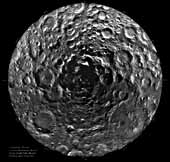|
COMETS EARTH JUPITER KUIPER BELT MARS MERCURY METEORITES NEPTUNE OORT CLOUD PLUTO SATURN SOLAR SYSTEM SPACE SUN URANUS VENUS ORDER PRINTS
PHOTO CATEGORIES SCIENCEVIEWS AMERICAN INDIAN AMPHIBIANS BIRDS BUGS FINE ART FOSSILS THE ISLANDS HISTORICAL PHOTOS MAMMALS OTHER PARKS PLANTS RELIGIOUS REPTILES SCIENCEVIEWS PRINTS
|
Related Document
Download Options
This mosaic is composed of 1500 Clementine images, taken through a red filter, of the south polar region of the Moon. These images were taken during the first month of systematic mapping. The top half of the mosaic faces Earth. Clementine has revealed what appears to be a major depression near the lunar south pole (center), evident from the presence of extensive shadows around the pole. This depression probably is an ancient basin formed by the impact of an asteroid or comet. A significant portion of the dark area near the pole may be in permanent shadow, and sufficiently cold to trap water of cometary origin in the form of ice. The impact basin Schrodinger (75S, 134E, at mosaic edge near the 4 o'clock position) is a two-ring basin, about 320 km in diameter. Clementine images have clarified the geological relations of Schrodinger. It is now recognized to be the second youngest impact basin on the Moon, younger than the great Imbrium basin on the near side, but older than the Orientale basin, as shown by the occurrence on Schrodinger of secondary craters formed by flying debris from the Orientale impact. The center of Schrodinger is flooded by lavas; these lavas are older than the crater Antoniadi (69S, 172W; 135 km diameter, at mosaic outer edge near the 6:30 position), as shown by the scoring of the lava surface by Antoniadi secondary craters. Finally, a volcanic vent seen in the floor of Schrodinger is one of the largest single explosive volcanoes on the Moon; its dark ash deposit overlies the secondary craters of Antoniadi, thus indicating that it is significantly younger than lavas filling the basin. The mosaic displays a rich variety of geological relations, the deciphering of which will take lunar scientists many years. |
